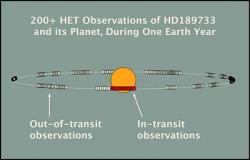Good timing. Just as Nick was mentioning how astronomers might be able to detect vegetation on extrasolar planets, we get this discovery: a ground based observatory has measured the atmosphere of an extrasolar planet for the first time. That holy grail of detecting the atmosphere on an Earth-sized world is getting closer and closer.
In a new journal article published in an upcoming issue of Astrophysical Journal Letters, astronomer Seth Redfield and colleagues report on their discovery.
The planet they’re studying orbits star HD189733, located about 63 light-years away in the constellation Vulpecula. It was originally discovered back in 2004. Unfortunately, this planet isn’t anything like the Earth; it’s actually about 20% more massive than Jupiter, and orbits its parent star 10 times closer than Mercury. Needless to say, it’s a hot world.
From our perspective here on Earth, HD189733b passes in front of its star on each orbit. As the planet “transits” across the star, it dims the light slightly. Furthermore, sunlight passing through its atmosphere can be measured distinctly from the star itself. The planet blocks about 2.5% of the star’s total light, and the atmosphere blocks an additional 0.3%.
And this was the technique that Redfield and his team used to measure the atmosphere. “Take a spectrum of the star when the planet is in front of the star,” explains Redfield. “Then take a spectrum of the star when it’s not. Then you divide the two and get the planet’s atmospheric transmission spectrum. Each time the planet passes in front of the star the planet blocks some of the star’s light. If the planet has no atmosphere, it will block the same amount of light at all wavelengths. However, if the planet has an atmosphere, gasses in its atmosphere will absorb some additional light.”
The atmosphere of an extrasolar planet has only been measured once before, using Hubble’s Space Telescope Imaging Spectrograph (STIS). Unfortunately, this instrument broke shortly after the previous detection. Without the help of Hubble, Redfield and his team needed to come up with another solution, so they switched to the Hobby-Eberly Telescope.
In the end, they made hundreds of observations spread out over a year taken under various conditions. They were able to remove the contamination of the Earth’s atmosphere from their observations, and come up with a good analysis of the planet’s atmosphere.
This is great, but it’s just a start. The real prize will come with astronomers are able to spot Earth-sized planets orbiting other stars, and measure their atmospheres. If they find large quantities of oxygen in the atmosphere, that’s a good candidate for life.
Original Source: McDonald Observatory News Release


I truly believe that one day such hard working astronomers will find an earth like planet.
Any actual data?
Note that, contrary to your assertion above, spectra of the atmospheres of both HD 209458b and HD 189733b have been obtained several times by the Spitzer Space Telescope. See Richardson et al. 2007, Grillmair et al. 2007, Swain et al. 2008, Tinetti et al. 2007, and others…
What was the planet like? What did the data show?
Well? They had the spectrum: what was the atmosphere composed of?
I wonder how many other objects blocked the light; changing the spectrum of the light traveling from the star or gravitational pulls.
Too bad we couldn’t put a satellite far out in our own solar system to test this process further against our own planet.
Very interesting though, probably at this stage only good for larger than Jupiter planets.
For both HD 209458b and HD 189733b, the Spitzer spectra appear to resemble blackbodies, with no obvious indications of water. This is rather surprising since most models of hot Jupiters predict a strong signature of water absorption. There are a number of possible explanations, including the sequestration of the water beneath cloud layers, or isothermal temperature profiles in the upper atmospheres. On the other hand, broad band measurements with the Spitzer IRAC camera during primary eclipse of HD 189733b may indicate that water is indeed present. Spitzer is currently making new spectral observations of both planets, with higher signal-to-noise ratios and extended wavelength coverage. The first lot of new data look very interesting but we have a lot of analysis ahead of us before we can make definitive statements. Stay tuned…
Cheers,
Carl
The paper is online on Astro-PH at http://arxiv.org/pdf/0712.0761
They detected sodium absorption in the planet’s atmosphere. I was curious about the press release; they said they divided the out-of-transit data by the in-transit data, but that won’t do it! But in the paper itself it says how they really did it (you have to do (in-out)/out) ).
Does anyone know why we have to always asume life needs oxygen? There could be life on Mars but we negelect to think outside the box. Here’s to finding life we don’t understand!
Celancha!!